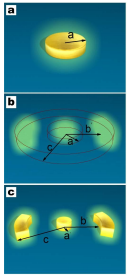Chinese Physicists Build “Ghost” Cloaking Device
 Illusion cloaks that make one object look like another are a fascinating type of invisibility device. The general idea is that such a device would make an apple look like a banana or a fighter plane look like an airliner. Clearly this would have important applications.
Illusion cloaks that make one object look like another are a fascinating type of invisibility device. The general idea is that such a device would make an apple look like a banana or a fighter plane look like an airliner. Clearly this would have important applications.
But while materials scientists have made great strides in building ordinary invisibility cloaks that work in the microwave, infrared and optical parts of the spectrum, making illusion cloaks is much harder. That’s because the bespoke materials they rely on require manufacturing techniques that seem like a distant dream.
Today, Tie Jun Cui and buddies at Southeast University in Nanjing, China, say they’ve designed and built a practical alternative to illusion cloaks, which they call a “ghost cloak”.
Conventional illusion cloaks rely on a two stage process. The first is a kind of invisibility stage which distorts incoming light to remove the scattering effect of the cloaked object, an apple for example. The second stage then distorts the scattered light to make it look as if it has been scattered off another object, a banana, for example. The result is that the apple ends up looking like a banana.
But materials that can perform this two-stage process are too demanding to make with current techniques.
So Tie Jun Cui and co have developed a single stage process that achieves a slightly different effect. Their idea is to do away with the first stage that makes the apple invisible.
Instead, their device takes the light scattered from the apple and distorts it to look like something else such as a banana. The symmetry of the effect–light is scattered on both sides of the apple–mean that this approach produces two “ghost” bananas, one on each side of the apple. The technique does not remove the apple entirely but distorts it, making it appear much smaller.
So the result is that the apple is changed into a much more complex picture that is significantly different from the original.
The big advantage of this approach is that it can be achieved now with existing technology. Tie Jun Cui and co first simulate the effect of their ghost cloak on a computer model.
They then go on to build a working prototype using concentric cylinders of split ring resonators that operates in 2 dimensions. They say that the results of their tests on this device closely match the results of the simulation.
That’s an interesting advance. The ability to distort and camouflage objects is clearly useful. However, an important question is whether the distortion that this device offers is good enough for any practical applications. Tie Jun Cui and co mention “security enhancement” but just how effective this would be when the original object is still visible, albeit in shrunken form, is debatable.
It may be that there are ways of improving the performance so it’ll be interesting to see what this team comes out with next.
Ref: arxiv.org/abs/1301.3710: Creation of Ghost Illusions Using Metamaterials in Wave Dynamics
Keep Reading
Most Popular
Large language models can do jaw-dropping things. But nobody knows exactly why.
And that's a problem. Figuring it out is one of the biggest scientific puzzles of our time and a crucial step towards controlling more powerful future models.
The problem with plug-in hybrids? Their drivers.
Plug-in hybrids are often sold as a transition to EVs, but new data from Europe shows we’re still underestimating the emissions they produce.
How scientists traced a mysterious covid case back to six toilets
When wastewater surveillance turns into a hunt for a single infected individual, the ethics get tricky.
Google DeepMind’s new generative model makes Super Mario–like games from scratch
Genie learns how to control games by watching hours and hours of video. It could help train next-gen robots too.
Stay connected
Get the latest updates from
MIT Technology Review
Discover special offers, top stories, upcoming events, and more.